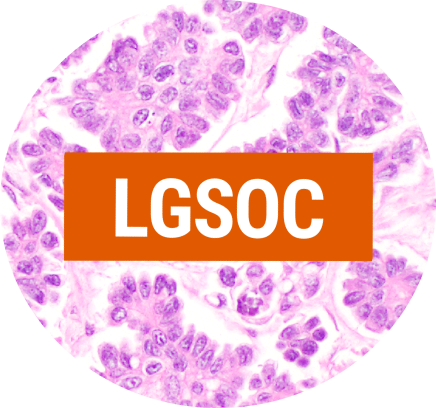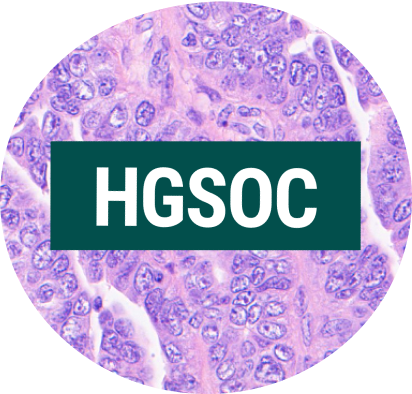

Home About LGSOC
Low-Grade Serous Ovarian Cancer (LGSOC)
What is LGSOC?
Low-grade serous ovarian cancer (also known as LGSOC) is a rare and serious ovarian cancer. It is distinct and different from the more common high-grade serous ovarian cancer (also known as HGSOC). LGSOC is likely to come back after initial treatment.
Low-grade serous ovarian cancer starts in the thin layer of tissue around the ovaries (also known as the epithelium) and can grow persistently.
Low-grade means that the cancer cells look a lot like normal cells.
Serous means that the cancer started in the serous membrane, which is part of the epithelium.

LGSOC affects younger people
LGSOC affects people at a broad range of ages, with large numbers between 20-30 years old and 50-60 years old. The average age at diagnosis for LGSOC is 43-48 years.
LGSOC is a rare cancer
About 5%
of all serous ovarian cancers are LGSOC
Nearly 2,000
new cases are diagnosed in the US each year
LGSOC symptoms
The symptoms of LGSOC are SERIOUS*
Stomach bloating
Eating less because you feel full
Repeated changes to bowel movements
Intense back and pelvic pain
Ongoing for up to 2 weeks
Urgent need to urinate
Stomach pain
*
This list is not exhaustive, as these are not all of the symptoms of LGSOC. Discuss any/all symptoms that you feel may be related to LGSOC with your doctor.

Diagnosing LGSOC
Because the LGSOC symptoms are similar to other diseases, like irritable bowel syndrome (IBS), it can be difficult to diagnose. It can take as long as 3 years to get an accurate LGSOC diagnosis.
- Up to 90% of patients with LGSOC are diagnosed at an advanced stage
- LGSOC is confirmed through a biopsy done by a pathologist, who may also perform what’s called germline and somatic testing to help your doctor guide treatment decisions
- If there has been no specific diagnosis for your type of ovarian cancer, consider getting a second opinion with a gynecologic oncologist with LGSOC experience

“Getting a second opinion is really important, especially for LGSOC, because it’s such a rare condition.”
–Kat, person living with LGSOC


Distinguishing LGSOC from HGSOC
LGSOC and HGSOC are two distinct and different cancers.
LGSOC
HGSOC
Uncommon
About 5% of serous ovarian cancers
Very common
About 95% of serous ovarian cancers
Affects younger people
The average age at diagnosis is 43-48 years, but has been diagnosed in people as young as 14 years old
Affects older people
Most people are over 60 years old when diagnosed
Normal-looking cells
Cells look like non-cancer cells
Abnormal-looking cells
Cells look unstructured or underdeveloped
Grows slowly
Cancerous cells grow slowly but persistently
Grows quickly
Cancerous cells grow quickly
Progresses slowly
Can start as benign (non-cancerous) before becoming cancerous and spreading
Progresses rapidly
Spreads quickly outside of ovaries
Less sensitive to chemotherapy
Other treatments may be required
Usually responds to chemotherapy
Responsive to chemotherapy, which can slow/stop the spread of cancer
LGSOC quiz
Low-grade serous ovarian cancer can be misunderstood, even by the healthcare community
The more you know, the better advocate you can be for your own health.
References
Babaier A, Mal H, Alselwi W, Ghatage P. Low-grade serous carcinoma of the ovary: The current status. Diagnostics (Basel). 2022;12(2):458.
Gershenson DM Low-grade serous carcinoma of the ovary or peritoneum. Ann Oncol. 2016;27(Suppl 1):i45-i49.
Slomovitz B, Gourley C, Carey MS, et al. Low-grade serous ovarian cancer: state of the science. Gynecol Oncol. 2020;156(3):715-725.
Gershenson DM, Bodurka DC, Lu KH, et al. Impact of age and primary disease site on outcome in women with low-grade serous carcinoma of the ovary or peritoneum: results of a large single-institution registry of a rare tumor. J Clin Oncol. 2015;33(24):2675-2682.
Gershenson DM, Cobb LP, Westin SN, et al. Contemporary primary treatment of women with stage II-IV low-grade serous ovarian/peritoneal cancer (LGSOC): determinants of relapse and disease-free survival. Gynecol Oncol. 2022;167(2):139-145.
National Cancer Institute. Tumor grade. Accessed April 14, 2025. https://www.cancer.gov/about-cancer/diagnosis-staging/diagnosis/tumor-grade
National Cancer Institute. Dictionary of cancer terms: serous membrane. April 14, 2025. https://www.cancer.gov/publications/dictionaries/cancer-terms/def/serous-membrane
Manning-Geist B, Gordhandas S, Liu YL, et al. MAPK pathway genetic alterations are associated with prolonged overall survival in low-grade serous ovarian carcinoma. Clin Cancer Res. 2022;28(20):4456-4465.
Matsuo K, Machida H, Grubbs BH, Sood AK, Gershenson DM. Trends of low-grade serous ovarian carcinoma in the United States. J Gynecol Oncol. 2018;29(1):e15.
Cleveland Clinic. Epithelial Ovarian Cancer. Accessed April 14, 2025. https://my.clevelandclinic.org/health/diseases/22250-epithelial-ovarian-cancer
Harvard Health. Certain symptoms may be early signs of ovarian cancer. Accessed April 14, 2025. https://www.health.harvard.edu/cancer/certain-symptoms-may-be-early-signs-of-ovarian-cancer
Cure Our Ovarian Cancer. About low grade serous ovarian cancer. Accessed April 14, 2025. https://cureourovariancancer.org/us/about/low-grade-serous-ovarian-cancer/
Srakocic S. Understanding low-grade serous ovarian cancer and its effects. Healthline. Accessed April 14, 2025. https://www.healthline.com/health/ovarian-cancer/low-grade-ovarian-cancer
De Decker K, Wenzel H, Bart, et al. Stage, treatment and survival of low-grade serous ovarian carcinoma in the Netherlands: A nationwide study. Acta Obstet Gynecol Scand. 2023;102:246–256.
Cleveland Clinic. Somatic and germline mutations. Accessed April 14, 2025. https://my.clevelandclinic.org/health/body/23067-somatic–germline-mutations
Ovarian Cancer Research Alliance (OCRA). High-grade serous carcinoma. Accessed April 14, 2025. https://ocrahope.org/news/high-grade-serous-carcinoma
Gershenson DM, Sun CC, Lu KH, et al. Clinical behavior of stage II-IV low-grade serous carcinoma of the ovary. Obstet Gynecol. 2006;108(2):361-368.
National Academies of Sciences, Engineering, and Medicine. Ovarian Cancers: Evolving Paradigms in Research and Care. The National Academies Press; 2016. Accessed April 14, 2025. doi:10.17226/21841
Zwimpfer TA, Tal O, Geissler F, Coelho R, et al. Low grade serous ovarian cancer – a rare disease with increasing therapeutic options. Cancer Treat Rev. 2023;112:102497.
Lisio MA, Fu L, Goyeneche A, Gao Z-H, Telleria C. High-grade serous ovarian cancer: basic sciences, clinical and therapeutic standpoints. Int J Mol Sci. 2019;20(4):952.
Grabowski JP, Harter P, Heitz F, et al. Operability and chemotherapy responsiveness in advanced low-grade serous ovarian cancer. An analysis of the AGO Study Group metadatabase. Gynecol Oncol. 2016;140(3):457-462.
Grisham RN, Slomovitz BM, Andrews N, et al. The highs and lows of serous ovarian cancer. Int J Gynecol Cancer. 2023;33(9):1331-1344.
Manning-Geist B, Kahn RM, Nemirovsky D, et al. Chemotherapy response in low‐grade serous ovarian carcinoma at a comprehensive cancer center: readdressing the roles of platinum and cytotoxic therapies. Cancer. 2023;129(13):2004-2012.
Gadducci A, Cosio S. Therapeutic approach to low-grade serous ovarian carcinoma: state of art and perspectives of clinical research. Cancers (Basel). 2020;12(5):1336.
Gockley A, Melamed A, Bregar AJ, et al. Outcomes of women with high-grade and low-grade advanced-stage serous epithelial ovarian cancer. Obstet Gynecol. 2017;129(3):439-447.
Manning-Geist BL, Cantor T, O’Cearbhaill RE, Grisham RN. Redefining the standard of care for low-grade serous ovarian cancer. Clin Adv Hematol Oncol. 2024;22(5):205-211, 226.
Okoye E, Euscher ED, Malpica A. Ovarian low-grade serous carcinoma: A clinicopathologic study of 33 cases with primary surgery performed at a single institution. Am J Surg Pathol. 2016;40(5):627-635.
Low-Grade Serous Ovarian Cancer (LGSOC) Patient Impact Survey. Harris Poll. 2023. Accessed April 14, 2025. https://letstalkaboutlgsoc-hcp.com/wp-content/uploads/2024/10/LGSOC-Patient-Impact-Survey-Research-Findings-1.pdf
Levanon K, Crum C, Drapkin R. New insights into the pathogenesis of serous ovarian cancer and its clinical impact. J Clin Oncol. 2008;26(32):5284-5293.
Dey P, Nakayama K, Razia S, et al. Development of low-grade serous ovarian carcinoma from bening ovarian serous cystadenoma cells. Cancers. 2022;14:1506.
Dao F, Schlappe BA, Tseng J, et al. Characteristics of 10-year survivors of high-grade serous ovarian carcinoma. Gynecol Oncol. 2016;141(2):260-263.
Rashid S, Arafah MA, Akhtar M. The many faces of serous neoplasms and related lesions of the female pelvis: a review. Adv Anat Pathol. 2022;29:154-167.
Everyday Health. Is it ovarian cancer or is it IBS? Accessed June 18, 2025. https://www.everydayhealth.com/ovarian-cancer/is-it-ovarian-cancer-or-ibs.aspx
Healthline. Understanding low-grade ovarian cancer and its effects. Accessed June 18, 2025. https://www.healthline.com/health/ovarian-cancer/low-grade-ovarian-cancer
Low-Grade Serous Ovarian Cancer Initiative. Low-Grade Serous Ovarian Cancer Guide. Accessed June 18, 2025. https://lgsoc.org/lgsoc-guide/
Roswell Park. Getting a second opinion of GYN cancer – 3 critical questions to ask. Accessed June 18, 2025. https://www.roswellpark.org/cancertalk/202010/getting-second-opinion-gyn-cancer-3-critical-questions-ask